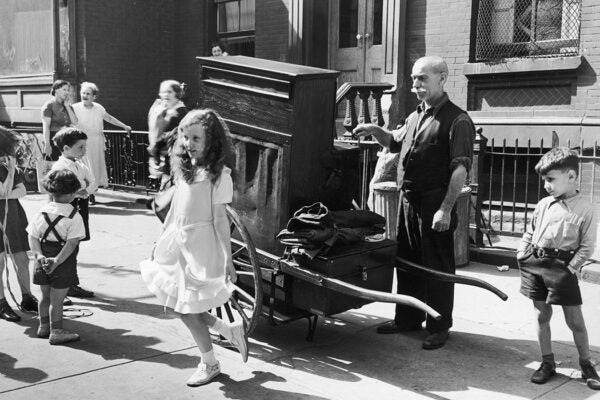In the recent book Feeling Asian American, social psychologist Wen Liu described a curious phenomenon: conservative Chinese American immigrants are adopting China’s rhetoric of the “Chinese dream” to buttress their own American politics as pro-police and anti-affirmative action.
Such first-generation diaspora nationalism—in which immigrants unite under ideologies from their birth and adopted countries—is not new; it extends a familiar story that goes back at least a century. Take for instance, the history of (im)migrants in California.
The agricultural heartland of California’s San Joaquin Delta was home to many hopeful migrants in the 1930s. But, as groups tussled for a slice of the pie, local tensions flared, writes historian Eiichiro Azuma. And, in a time before political alliances among Asians in the United States were the norm, Issei (first-generation Japanese Americans) tried to carve out space via conflict with their Filipino neighbors.
This animosity, which the Issei characterized in explicitly racial terms, was part of their unique new identity “as delta-Japanese immigrants,” writes Azuma. Even as they embraced American citizenship for their children, Issei clung to “overseas racial development” (minzoku no kaigai hatten)—an idea that “appeared in the pages of Japanese-language newspapers virtually every day” and circulated in books and speeches, too.
“This peculiar logic made perfect sense to Issei as well as many older Nisei,” he adds. “In their vocabulary, the concept had little association with colonialism or imperialism, while in Japan ‘racial/national development’ meant precisely colonial expansion and domination.”
Issei were acutely aware of negative attitudes in Japan toward poor farmers who had left the country. So, “overseas racial development” was one way for them to “valorize their position in relation to their homeland state,” Azuma explains.
“Juxtaposing their own struggle against racial exclusion with the rise of Imperial Japan in a world dominated by the West, Issei considered themselves the ‘forerunners’ or ‘pioneers’ (senkusha) of Japan’s overseas expansion.”
Japanese farmers had been working in the San Joaquin Delta since the start of the twentieth century, serving as tenant farmers for white landlords after restrictions on Chinese immigrants kicked in. But the Issei suffered a double whammy from an “alien land law” in 1920, which barred them from leasing and owning land, and the Immigration Act of 1924, which closed the borders to Japanese.
These changes “brought to the delta an influx of Filipinos, who quickly dominated the local labor market and gradually threatened Japanese tenancy,” notes Azuma. Many Japanese farm workers lost their jobs, with the exception of some foremen, while Filipino laborers became integral to the local economy.
The situation came to a head in 1930, after an American-born Japanese woman reportedly eloped with a Filipino laborer—and then, under pressure from her father, left her husband.
The news sparked outrage in the Filipino community and led to a months-long boycott of Japanese businesses in the city of Stockton, which was also supported by the Filipino white-collar class. For the Issei, the boycott was seen as a serious risk to their financial interests. Tellingly, though, their response was also linked to a fear of interracial relationships, which threatened “their belief in the purported superiority of the Japanese race,” as Azuma puts it.
While their racial ideology was influenced by an imperialist Japanese doctrine, “which sought to dominate ‘backward races’ in Asia,” it was also adapted for the San Joaquin Delta, Azuma writes, noting that
the concept [of “overseas racial development”] enabled Issei to imagine race relations in the delta as a manifestation of the hierarchical power relations of nation states. As Japan enjoyed supremacy over all other Asian nations, so Japanese in the delta should keep Filipinos and other “third-class” races in a subordinate position. Of course, whites were excluded from this picture, for they represented the real power in the delta.
Indeed, the American racial hierarchy meant Issei farmers and businessmen also had to tweak “overseas racial development” to accommodate a white land-owning class in the United States. For example, Issei presented themselves and their Nisei (second-generation) children as having “innate farming skills and superior racial qualities” that “could not only contribute to American society but also live a respectable life in harmony with white Americans.”
Weekly Newsletter
Notably, the Japanese-led California Farm Labor Union successfully cut off an agricultural strike in 1941, putting an end to a thorn in their side from the Filipino Agricultural Laborers’ Association. Just months later, however, Japan bombed Pearl Harbor and the “delta-Japanese” identity, “as well as the nationalism that supported that identity, became untenable.”
Losing their contracts and their customers,
the Japanese community was quickly eliminated from the delta’s political economy, even before their mass removal from the West Coast. […] Because only the white elites enjoyed the benefits of the status quo in this hierarchy, Japanese residents were ultimately the losers of their own “race war.”
Fundamentally, Azuma writes, the Japanese racial ideology, which “rationalized that conflict [with Filipino laborers] and drove them to become the ‘oppressor’ and the oppressed simultaneously, was a peculiar by-product of the delta’s white hegemony and its racist ideology.”







